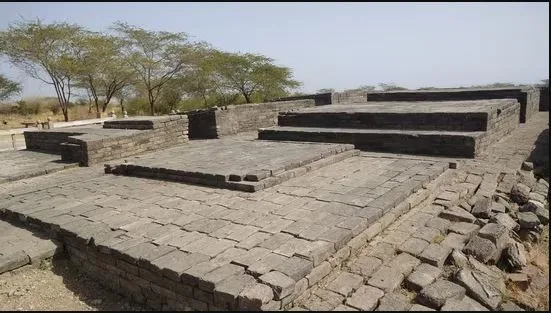Syllabus: GS1/Ancient Indian History
Context
- New study has suggested the existence of a dockyard at Lothal, Gujarat, during Harappan Civilisation.
Major Findings
- The study has revealed that the Sabarmati river used to flow by Lothal (currently, it flows 20 km away from the location) during the Harappan Civilisation.
- There was also a travel route connecting Ahmedabad, through Lothal, the Nal Sarovar wetland, and the Little Rann, to Dholavira — another Harappan site.
- The researchers based their study on the hypothesis that from Lothal, there was an inland network connected to the Rann of Kutch.
- The study suggests that traders came to Gujarat through the Gulf of Khambhat, probably went to Ratanpura to get materials, and carried them to Mesopotamia (modern-day Iraq).
- The research supports the dockyard theory and addresses concerns about historical inlets, demonstrating Lothal’s importance for trade via river and sea routes.

Lothal
- Lothal (‘the mound of the dead’ in Gujarati) was discovered under a mound among marshy fields of the Saragwala village.
- The presence of Harappan town planning at Lothal such as houses, bathing platforms, streets, fortification walls, a cemetery and large structures, easily allowed it to be accepted as an outpost of Harappan civilisation.
- It was concentrated in a northwest arch starting at Sindh/Balochistan and going up to present day Haryana.
- Since it was discovered in the 1950s and postulated to be a dockyard, archaeologists and experts have been divided.
- Some argued that Lothal was a Harappan dockyard based on discoveries at the site, including a 222 x 37 metres basin (claimed to be a dockyard), a wharf to anchor the ships or boats, and artefacts such as Harappan seals.
- However not all accept the dockyard theory, they argue that it was only in modern times that Indian ports came to be directly situated on the sea.
Other Evidences that Support Sea Trade
- There are numerous temples to goddess Sikotara in Gujarat, which is named after the island of Socotra, which is situated at the mouth of the Red Sea and served as a haven to Indian sea-farers more than 2,000 years ago.
- Numerous inscriptions in Brahmi script show that Indians used this island as an important halt on the trading route to the Middle East and East Africa.
Harappan Civilization
- The Harappan civilization is believed to be one of the oldest world civilizations together with Egypt and Mesopotamia.
- It was developed along the river Indus and for that reason it is also known as the Indus Valley Civilization.
- The Harappan civilization is identified as a Bronze-age civilization because many objects have been found that are made up of copper based alloys.
Major Features of Civilization
- Urban Planning: Their towns were well planned and they had brick houses which were situated along the roads.
- Every house was equipped with a staircase, a kitchen and several rooms.
- Their courtyards had wells, bathrooms and they had proper drainage systems.
- Ornaments: The Harappans wore ornaments made of gold, silver, ivory,shell, clay, semi-precious stones and others.
- Trade and Commerce: The civilization had extensive trade networks, reaching as far as Mesopotamia, Afghanistan, and the Arabian Peninsula.
- Religion and Iconography: Harappan artifacts depict various symbols and motifs believed to be related to religious beliefs.
- These include figures such as the “Priest King” and images of animals like bulls, suggesting possible reverence for certain animals.
- Craftsmanship and Artistry: The Harappans produced intricate pottery, including the famous red pottery with black painted motifs.
- They also created jewelry, sculptures, and seals made of steatite, terracotta, and other materials.
- Agriculture: They cultivated crops such as wheat, barley, peas, and cotton.
- Social Organization: The society was likely stratified, with evidence suggesting a hierarchical structure. This is indicated by variations in housing sizes and the presence of public buildings.
- Decline and Disappearance: The reasons for the decline of the Harappan Civilization are still debated among historians and archaeologists.
- Possible factors include ecological changes, such as shifts in river courses, as well as invasions and internal conflicts.
Major Harappan Sites
| Site | Present Day |
| Harappa | Punjab, Pakistan |
| Mohenjo-Daro | Sindh, Pakistan |
| Dholavira | Kutch district of Gujarat, |
| Kalibangan | Rajasthan |
| Lothal | Gujarat |
| Rakhigarhi | Haryana |
| Chanhudaro | Sindh, Pakistan |
| Ganweriwala | Punjab, Pakistan |
| Sutkagendor | Baluchistan Province, Pakistan |
| Alamgirpur | Uttar Pradesh |
Source: IE
Previous article
Accelerate Safety Measures to Reduce Road Traffic Deaths
Next article
A brief history of Iran-US Ties